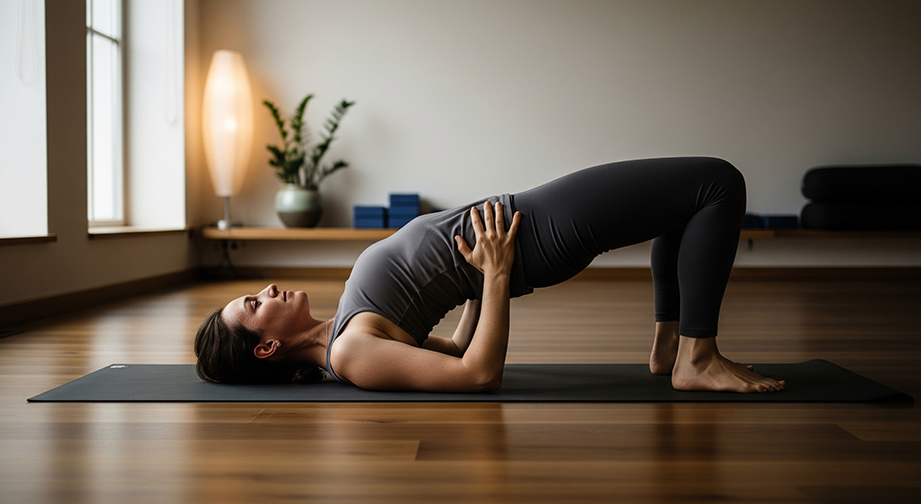Setu Bandha Sarvangasana (Shoulder Supported Bridge Pose): A Complete Beginner’s Guide
Introduction
Setu Bandha Sarvangasana—also known in English as the Shoulder Supported Bridge Pose—is a gentle, chest-opening yoga posture that can soothe tension and restore balance. In Sanskrit, setu means "bridge," bandha means "lock," and sarvanga means "all limbs" or "the whole body." The essence of this yoga asana is deeply calming and restorative, making it a favorite among yogis seeking to relax mind and body.
If you’ve ever felt stiff after sitting too long or struggled with a tight lower back, Setu Bandha Sarvangasana could become your best friend—offering relief and ease in just a few breaths.
Step-by-Step Guide

- Set Up: Lie flat on your back with your knees bent and feet hip-width apart. Place your arms by your sides, palms facing down.
- Feet & Knees: Bring your heels close to your sitting bones, so your fingertips can gently brush them. Keep knees directly above your ankles.
- Press & Lift: Inhale and press your feet and arms into the mat. Gradually lift your hips toward the ceiling.
- Shoulder Support: Roll your shoulders underneath your body, tucking your upper arms close. Clasp your hands beneath your back if comfortable.
- Steady & Breathe: Stay for 5–7 slow, gentle breaths. Inhale to lift and lengthen; exhale to soften the chest and jaw.
- Release: On an exhale, gently unclasp your hands, roll your spine down one vertebra at a time, and rest.
- Repeat: Practice up to 3 rounds, holding for 30 seconds to 1 minute each time.
Modification for Beginners: Place a yoga block or bolster under your sacrum (the triangle-shaped bone at the base of your spine) for extra support. Keep your hands by your sides.
To Intensify: Lift one leg at a time (Eka Pada Setu Bandha Sarvangasana), or interlace fingers and wiggle shoulders closer under the body for a deeper lift.
Alignment & Safety Tips
- Alignment cues: Keep knees hip-width—and don’t let them splay out. Press evenly into all four corners of your feet.
- Avoid arching the neck. Keep chin slightly away from the chest without pressing it in.
- Do not squeeze the glutes—lift from the inner thighs and core.
- Common mistakes: Knees flaring, over-arching the lower back, or turning feet outwards.
- Remember to breathe steadily rather than holding your breath.
- Safety: Avoid this position if you are pregnant, have recent neck/back injuries, uncontrolled high blood pressure, or glaukoma. Consult your physician if unsure.
Benefits of Setu Bandha Sarvangasana
Physical Benefits
- Stretches the chest, neck, spine, and hip flexors
- Strengthens glutes, hamstrings, and lower back
- Improves posture and spinal mobility
- Stimulates the thyroid and lungs
Mental Benefits
- Relieves mild stress and anxiety
- Promotes relaxation and mental clarity
- Invites a sense of comfort and calm
Energy & Chakra Connection
- Balances the Heart Chakra (Anahata)—opening to new energy, compassion, and joy
- Gently stimulates the Throat Chakra (Vishuddha)—improving communication and expression
Contraindications
- Pregnant women (especially second and third trimester)
- Recent or chronic injury to the neck, shoulders, or back
- Glaucoma or uncontrolled high blood pressure
- Migraines or any vertigo/dizziness
Safe Alternatives: Try Supported Bridge with a bolster or Constructive Rest Pose (knees bent, feet wide, knees touching) instead.
Beginner’s Tips & Variations
- Use a block or bolster under the sacrum for supported bridge.
- Place a folded blanket under the shoulders for soft neck support.
- Keep hands by the sides if clasping is uncomfortable.
- For advanced yogis: Try lifting a leg, or rise onto the balls of your feet for a deeper stretch.
How to Include in a Yoga Flow
- Works beautifully as part of your cool-down or as a gentle heart-opener in the middle of practice.
- Pairs well with Supta Baddha Konasana (Reclining Bound Angle Pose) before, or Apanasana (Knees-to-Chest Pose) after.
- Try Cat-Cow Pose before bridge to mobilize the spine.
Mind-Body Connection
Move into Setu Bandha Sarvangasana slowly, using each breath to check in with your body and soften. This pose gently opens the heart to renewal and gratitude, and fosters a sense of groundedness through mindful awareness.
Spiritually, this posture is said to awaken both the heart (love, acceptance) and throat (truth, communication) chakras, encouraging openness and connection both within and outward.
Asana Name: Shoulder Supported Bridge / Setu Bandha Sarvangasana
Level: Beginner-Friendly
Focus Areas: Back, shoulders, chest, glutes, hamstrings
Duration: 30 seconds to 1 minute per round (repeat up to 3 times)
Best Time to Practice: Morning or Evening, as part of warm-up or cool-down
FAQs about Setu Bandha Sarvangasana
- Is Setu Bandha Sarvangasana safe for beginners?
Yes! This yoga bridge pose is beginner-friendly, especially when props are used for support. Always listen to your body and don’t push into pain.
- What are the main benefits of Shoulder Supported Bridge?
This asana strengthens the back and glutes, opens the chest, and calms the mind. It may also relieve stress and help improve spinal flexibility.
- Can I practice Setu Bandha Sarvangasana during pregnancy?
It is best to avoid this pose during pregnancy, especially after the first trimester. Try a supported restorative bridge with lots of props instead—and always consult your physician.